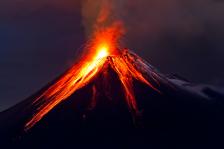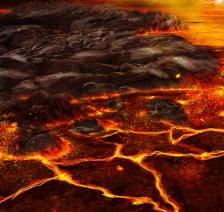What Is a Volcano?
From Chile to Hawai‛i to Yellowstone to Oregon, volcanoes have been “erupting” in the headlines over the past week. Each one of these powerful eruptions has its own unique story. How do volcanoes form? Are eruptions always dangerous?
Sabrina Stierwalt, PhD
Listen
What Is a Volcano?

Hi! I’m Sabrina Stierwalt, Ask Science, bringing you Quick and Dirty Tips to help you make sense of science.
Volcanoes remind us that our planet is active, and that even the ground beneath our feet is ever changing. Four volcanoes from Chile, Hawai‛i, Yellowstone, and Oregon have made headlines in the last week alone, but each with its own unique story. Let’s explore the causes of these powerful eruptions.
.
What Is a Volcano?
A volcano is formed when the pressure below the Earth’s surface builds enough to cause a rupture that then forces the release of the hot magma and gas below. These eruptions can be dramatic, with ejecta traveling at hundreds of miles per hour, or they can be calmer like a slow ooze. While volcanologists disagree over which volcanoes can be labeled active versus extinct, the number of active volcanoes on Earth is somewhere around 1,500.
The Earth’s crust is not solid, but instead is made up of a series of large plates, somewhat like large puzzle pieces, that can move and shift over time. Volcanoes are usually formed where these so-called tectonic plates are either converging (like in the band circling the Pacific Ocean, known as the Pacific Ring of Fire) or diverging (like in the Mid-Atlantic Ridge).
Friction from these shifting plates heats the magma, or molten rock, below the Earth’s surface much like how rubbing your hands together will warm them up. The increased temperature can lead to a build-up in pressure that eventually explodes through the Earth’s crust, forcing the magma (which is called lava once it reaches the surface) to pour out.
Volcanic eruptions can cause mass devastation. Mount Vesuvius, near Naples, Italy, buried the cities of Pompeii and Herculaneum and their residents in an eruption in the year 79 AD. Vesuvius continues to erupt on roughly a 20-year cycle, although the last major eruption was in 1944. The volcano is still classified as one of the most dangerous volcanoes in the world due to the hundreds of thousands of people that live nearby.
But volcanoes aren’t all destruction; they serve a positive purpose as well. Over time they have created a large fraction of the Earth’s surface, including the Hawai‛ian island chain, through the ejection and then the eventual cooling and settling of material. They also provide rich soil for farming, and in some cases, their geothermal energy can be harnessed for our energy needs.
So which volcanoes have been “erupting” in the news lately?
Chile’s Calbuco Volcano

The ashen debris stacks as high as 2 feet in some areas, and has spewed as far as Argentina. Since the last major eruption for Calbuco was in 1962, this latest event caught many off-guard.
Also included in the 200 million cubic meters of ash and rock bursting from below the surface is a large amount of sulfur dioxide gas, the climate effects of which are not yet understood.
Oregon’s Axial Mount
About 250 miles off the coast of Oregon and Washington, at the site of 2 diverging tectonic plates, the active, underwater Axial Volcano is believed to have also erupted this week. Thousands of small earthquakes have been detected, and the sea floor surrounding the volcano has dropped by eight feet, suggesting magma is shifting and even escaping. Luckily for residents of the northwestern US, the seismic activity is not expected to reach land or be intense enough to cause any tsunamis.
The activity is well documented, as the Axial Volcano is home to NeMO—the first underwater volcano observatory that studies the biology, chemistry, and geology of such eruptions on the sea floor.
Underwater volcanic eruptions bring heat to the surface that then creates hot springs called hydrothermal vents. These vents provide a unique environment for life not found elsewhere on Earth, and may actually be close analogs to where life on our planet originally began.
Kilauea, the Most Active Volcano
The Hawai‛ian Islands, which were formed by volcanic activity, are not near converging or diverging tectonic plates, but instead lie in the middle of the
Kilauea, on the island of Hawai‛i, may be the most active volcano in the world. Fortunately for residents of the Big Island, Kilauea is a shield volcano, or one that is built up from fluid magma flows. Shield volcanoes are large in size, but tend to send erupted material in all directions, and that lava can travel much farther before solidifying. These events end up being calmer than more directed, high-speed eruptions.
Kilauea has been known for constant eruptions for over 30 years, and during that time its activity level has varied. Two of its craters, Halema‛uma‛u and Pu‛u O‛o, are filled with lakes of lava, the heights of which are observed to rise and fall. The volcano has made news recently because the lava lake at Halema‛uma‛u has overflowed, taking part of the crater’s edge with it. This crater is well within the confines of the edges of the very large volcano, however, and thus is not cause for concern.
Yellowstone Supervolcano
Another hot spot like the one that created the Hawai‛ian Islands lies beneath the surface of Yellowstone National Park. The pressure and magma build up caused by some hot spots is not always able to break through, causing an ever-increasing pool of magma to accumulate below the surface. This build up can create supervolcanoes, or volcanoes capable of spewing more than a volume of 1,000 cubic kilometers (240 cubic miles) of molten rock and gas in an eruption.
The Yellowstone supervolcano was known to be large, but a recent study found it to extend far beyond what was originally thought. The size of the magma reservoir was traced by seismic waves, which travel slower through hot, molten rock than they do through cold, solid rock. The seismologists found two reservoirs that supply Yellowstone: one as deep as 50 kilometers, and a shallower one that reaches only 17 kilometers in depth but extends about 90 kilometers long (2.5 times the size estimated by a previous study).
However, the overall volume of the magma we know to sit below the surface at Yellowstone has not changed, and so these findings don’t affect the hazard rank for the volcano. Instead, geologists have a better understanding of how far the volcano’s influence extends and what powers such a supervolcano.
You can check the status of Yellowstone, Kilauea, and other U.S. volcanoes on the United States Geological Survey website.
Until next time, this is Sabrina Stierwalt with Ask Science’s Quick and Dirty Tips for helping you make sense of science. You can become a fan of Ask Science on Facebook or follow me on Twitter, where I’m @QDTeinstein. If you have a question that you’d like to see on a future episode, send me an email at everydayeinstein@quickanddirtytips.comcreate new email.
Tungurahua Volcano eruption, Erupting volcano near water, and Volcanic terrain landscape illustration images from Shutterstock.

